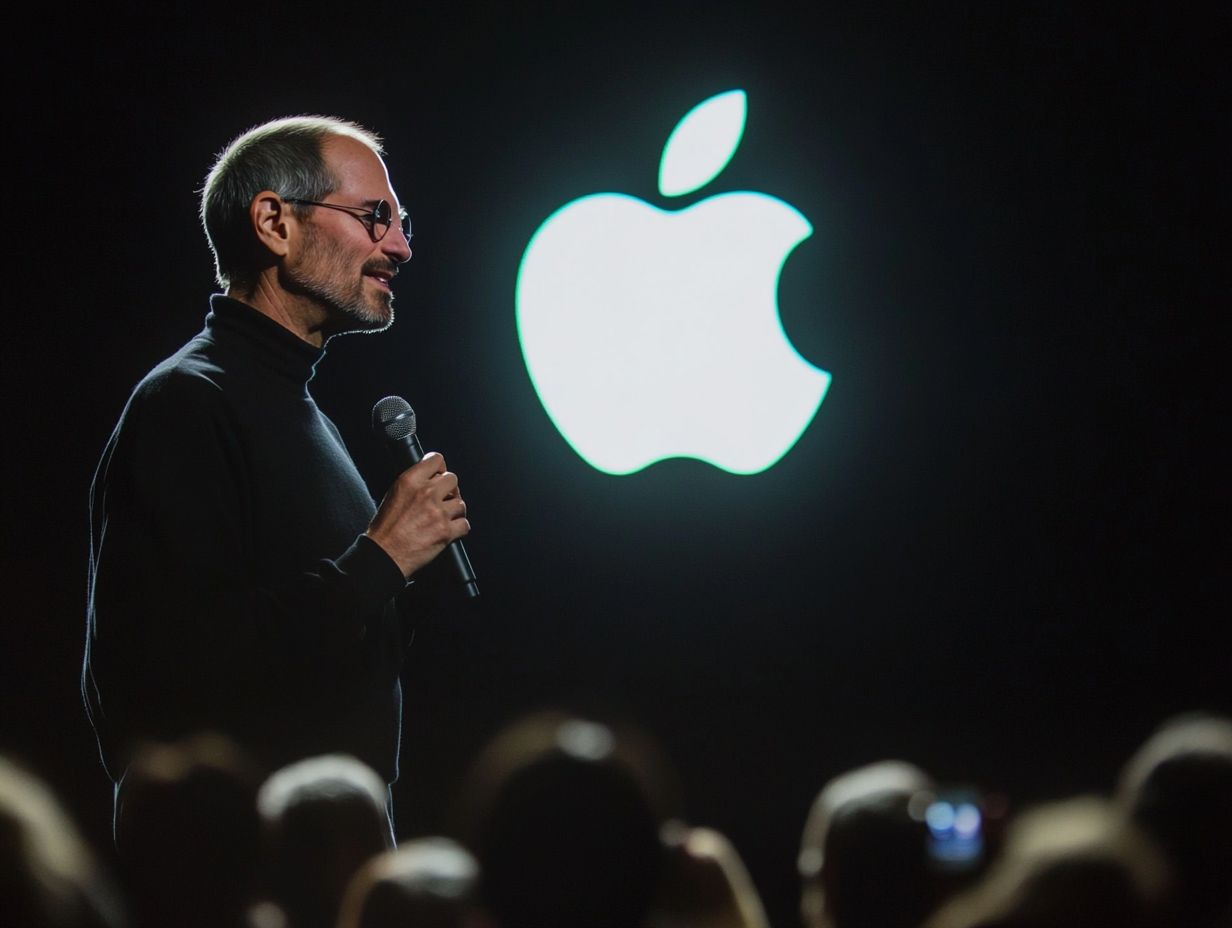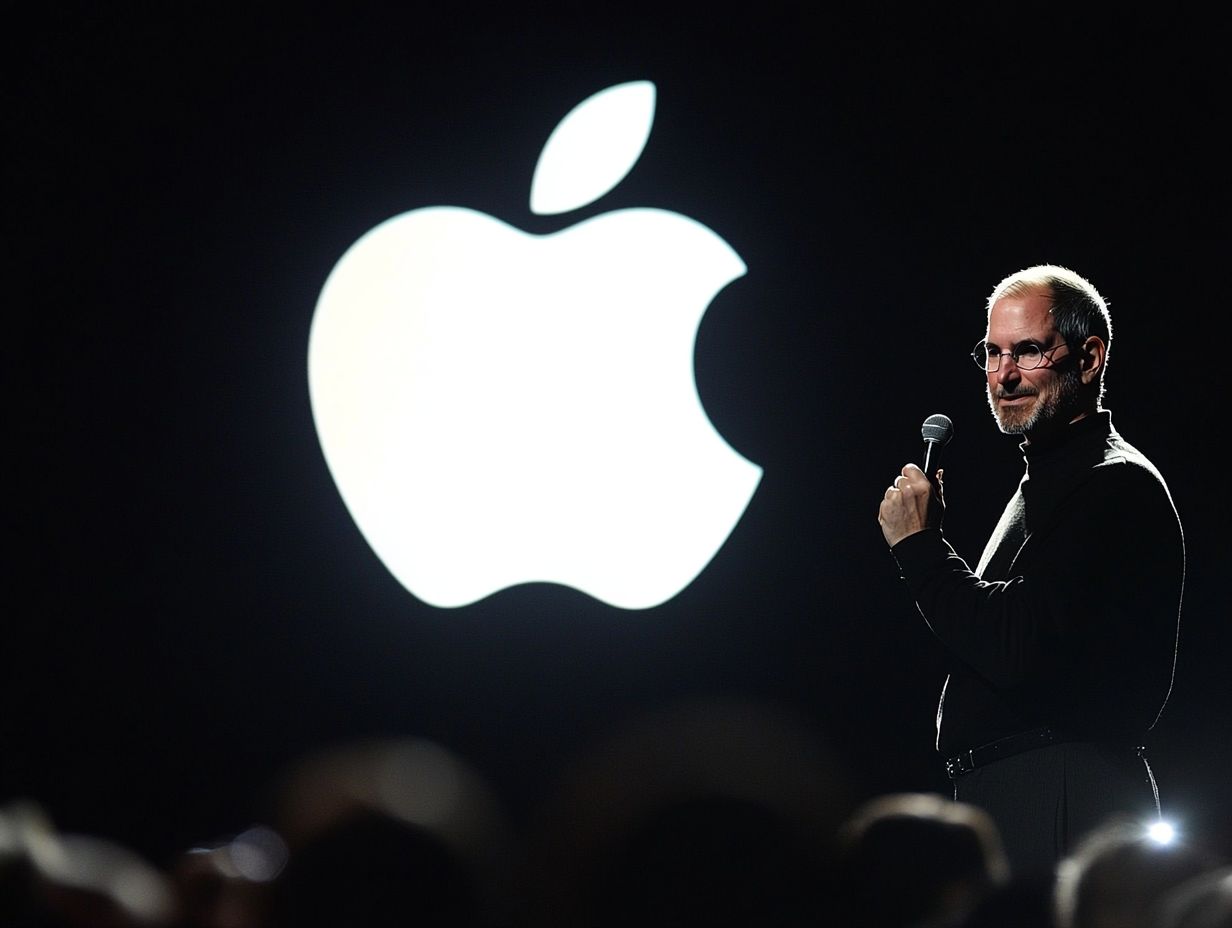Steve Jobs: Lessons from His Life and Legacy
Steve Jobs was a visionary whose influence on technology and design still echoes in the world today.
From his unconventional childhood to co-founding Apple Inc., his journey through life reveals a powerful testament to creativity and determination.
This exploration delves into his groundbreaking innovations in personal computing, music, and entertainment, highlighting the principles that shaped his distinctive leadership style.
You ll uncover invaluable lessons drawn from his life, underscoring the significance of vision and persistence.
Join us in celebrating the legacy of a true pioneer.
Contents
- Key Takeaways:
- Early Life and Career of Steve Jobs
- Innovations and Contributions of Steve Jobs
- Leadership Style and Philosophy of Steve Jobs
- Lessons Learned from Steve Jobs
- Frequently Asked Questions
- Who was Steve Jobs and why is he famous?
- What are some lessons we can learn from Steve Jobs’ life?
- How did Steve Jobs’ legacy impact the technology industry?
- What stirred the most debate about Steve Jobs’ life and legacy?
- Why is it important to study Steve Jobs’ life and legacy?
- How did Steve Jobs’ influence extend beyond the technology industry?
Key Takeaways:

- Steve Jobs’ early life and education shaped his innovative mindset and passion for technology, leading to the founding of Apple Inc.
- His contributions to the personal computer and music industries revolutionized and set new standards for design and user experience.
- Jobs leadership style and philosophy inspire creativity and emphasize the importance of vision and persistence in achieving success.
Early Life and Career of Steve Jobs
Steve Jobs, the visionary co-founder of Apple Inc., was born on February 24, 1955, in San Francisco. He was raised in Cupertino, California, where his interest in technology and design could truly blossom.
His childhood was marked by a deep curiosity about electronics, explored through various projects. However, it was his time at Reed College and later at Stanford University that really sharpened his business mindset and innovative approach.
These experiences set the stage for his future ventures in personal computing and consumer electronics, ultimately leading to the founding of one of the most transformative technology companies in history.
Childhood and Education
Steve Jobs childhood in Cupertino was defined by an early fascination with electronics that significantly shaped his creativity and innovative spirit in technology.
Growing up in a family that championed exploration and curiosity, you might picture him often dismantling gadgets just to grasp their inner workings. This passion laid the groundwork for his future endeavors.
His time at Reed College introduced him to a rich tapestry of ideas and artistic influences. It nurtured the belief that technology should not merely function but also evoke an emotional response.
Jobs brief stint at Stanford University further polished his vision. It instilled an unwavering pursuit of excellence and an appreciation for design as a core component of how people interact with technology.
These formative experiences crafted his identity as a transformative leader in both technology and design, ultimately guiding him to revolutionize the way consumers engage with their devices.
Founding of Apple Inc.
In 1976, a pivotal moment in technology occurred as Steve Jobs co-founded Apple Inc. with Steve Wozniak and Ronald Wayne. They reshaped the landscape of personal computing with their groundbreaking vision.
Together, they imagined a world where technology was not only accessible but also user-friendly. They laid a solid foundation for revolutionary products like the Apple I and Apple II.
These early computers didn’t just boast remarkable design and functionality; they embodied the entrepreneurial spirit of their founders, unafraid to challenge the status quo.
Jobs’s sharp marketing acumen, Wozniak’s engineering brilliance, and Wayne’s initial investment created a launchpad for a wave of innovations that ultimately paved the way for competitors like Microsoft to introduce Windows.
With a steadfast commitment to simplicity and style, Apple began its remarkable ascent in the tech industry, forever changing the way we interact with technology.
Innovations and Contributions of Steve Jobs
Steve Jobs’ innovations have profoundly transformed various industries, ranging from personal computing to consumer electronics.
With iconic products like the iPhone and iPod, he emphasized user experience the way people interact with technology and feel about it and design simplicity, elevating these aspects to new heights.
His visionary leadership at Apple didn’t just revolutionize technology; it turned it into a cultural phenomenon that continues to influence how we live and interact today.
Revolutionizing the Personal Computer Industry

Steve Jobs played a pivotal role in transforming the personal computer industry by introducing user-friendly hardware and software solutions through Apple. His vision reshaped how people interact with technology. He made computers more accessible and appealing to the everyday individual.
The launch of the Macintosh in 1984 was a defining moment, showcasing an intuitive graphical user interface, which is the way users interact with computers through visual elements like icons and buttons. This demystified computing for users. By emphasizing design and usability, Jobs set a new benchmark for personal computing, merging aesthetics with functionality in a way that resonated deeply.
Innovations such as the click-and-drag feature and the inclusion of a mouse revolutionized the user experience. These advancements allowed for seamless navigation and interaction. With these innovations, Apple attracted not just the tech-savvy, but also engaged those who were previously unfamiliar with computers. This fundamentally altered how people perceive and utilize technology in their daily lives.
Impact on the Music and Entertainment Industry
The launch of the iPod and iTunes represents a pivotal moment in the music and entertainment industry, illustrating how effectively Steve Jobs merged technology with consumer needs.
The iPod and iTunes changed how you listen to music. They fundamentally transformed the landscape of digital distribution. With seamless synchronization and a vast library of songs at your fingertips, people transitioned from buying physical albums to enjoying on-demand content. This shift kicked off a thrilling new era for music lovers, defined by convenience and personal choice.
iTunes opened the door for artists to reach a broader audience, significantly changing the dynamics of the music business. It gave power to indie labels to thrive and provided you with unprecedented control over your music preferences.
Legacy of Design and User Experience
Steve Jobs’ legacy is firmly anchored in his relentless commitment to design and user experience. He established a benchmark for innovation in technology that many strive to replicate.
His philosophy centered on the notion that technology should be both efficient and intuitive. He merged aesthetics with functionality for seamless interaction. By placing a premium on simplicity, Jobs conveyed that the most remarkable products often eliminate unnecessary complexity, enabling users to engage with technology more naturally.
This dedication to user-centric design resulted in iconic products that transformed entire industries. It broadened technology’s accessibility. Thus, the ideals of innovation and simplicity became synonymous with Apple’s success, cultivating a devoted fanbase and continually urging competitors to reevaluate their design strategies.
Leadership Style and Philosophy of Steve Jobs
Steve Jobs’ leadership style embodies a remarkable fusion of vision, creativity, and an unwavering dedication to perfection. This distinctive approach sculpted Apple’s innovative culture and influenced the design of its iconic corporate campus, Apple Park.
Key Principles and Practices
Steve Jobs embraced key principles and practices that placed innovation and a profound understanding of consumer needs at the forefront, ultimately fueling Apple’s remarkable success.
His vision extended far beyond simply developing products; it was about crafting an ecosystem that delighted users and redefined their experience. Jobs believed that technology should seamlessly weave into everyday life. He embodied a hands-on philosophy that prioritized customer-centric design in every aspect of product development.
This approach meant not just meeting consumer demands but anticipating them. This led to revolutionary innovations like the iPhone and iPad. His relentless focus on aesthetics combined with functionality highlighted a corporate strategy that consistently challenged the status quo. It inspired teams to think differently and push the boundaries of what was possible in the tech industry.
Lessons Learned from Steve Jobs

The journey of Steve Jobs presents invaluable lessons in creativity and innovation. It emphasizes the importance of maintaining a clear vision and demonstrating perseverance, especially when faced with failure.
His experiences illustrate that setbacks can often pave the way for new opportunities. They encourage you to embrace challenges as stepping stones to success.
Inspiring Creativity and Innovation
Steve Jobs’ approach to nurturing creativity and innovation exemplifies how inspiration and motivation can propel groundbreaking ideas. By creating an environment where everyone could share ideas, he transformed Apple into a true incubator for revolutionary thought.
Jobs championed collaboration across teams, ensuring that a variety of perspectives shaped product development. He cultivated a mindset that welcomed risk-taking, making it clear that failure was simply a stepping stone on the path to success.
This philosophy encouraged his teams to push boundaries, ultimately resulting in iconic products like the iPhone and iPad. His visionary leadership ignited a spark within each employee, inspiring them to think differently and challenging them to innovate without fear.
Importance of Vision and Persistence
The importance of having a clear vision and relentless persistence in achieving success is vividly illustrated by Steve Jobs’ transformative journey in the technology industry.
Throughout his career, you can see how Jobs possessed an extraordinary ability to anticipate technological trends and consumer desires, charting a course for innovation that many struggled to grasp. This remarkable foresight, combined with his unwavering determination, gave him the power to navigate numerous challenges, transforming potential setbacks into stepping stones for growth.
As he continuously pushed the boundaries of creativity and functionality, Jobs not only redefined the personal computing landscape but also fostered a culture of excellence within Apple. His commitment to perfection inspired his team to strive for greatness, ultimately culminating in groundbreaking products that resonated with millions and solidified Apple s status as a leader in the tech industry.
Frequently Asked Questions
Who was Steve Jobs and why is he famous?
Steve Jobs changed the tech landscape as an American entrepreneur and business magnate, best known as the co-founder and CEO of Apple Inc. He is famous for his visionary leadership and innovative products such as the Macintosh computer, iPod, iPhone, and iPad.
What are some lessons we can learn from Steve Jobs’ life?

Some of the lessons we can learn from Steve Jobs’ life include the importance of following your passion, taking risks, embracing failure, and constantly challenging yourself to think differently.
How did Steve Jobs’ legacy impact the technology industry?
With his revolutionary products and unique approach to design and user experience, Steve Jobs’ legacy has profoundly impacted the technology industry. He changed the way we use and interact with technology, making it more accessible and user-friendly.
What stirred the most debate about Steve Jobs’ life and legacy?
The most controversial aspect of Steve Jobs’ life and legacy is his management style and treatment of employees. Some have criticized him for being harsh and demanding, while others argue that it was necessary for his success and the success of Apple.
Why is it important to study Steve Jobs’ life and legacy?
Studying Steve Jobs’ life and legacy can provide valuable insights into entrepreneurship, leadership, and innovation. Exploring the vision of Steve Jobs can also serve as a source of inspiration and motivation for individuals looking to make a positive impact in their own industries.
How did Steve Jobs’ influence extend beyond the technology industry?
Steve Jobs’ influence extended beyond the technology industry to the fields of design, marketing, and business strategy. His emphasis on simplicity and intuitive design has been adopted by companies in various industries, and his marketing tactics have been studied and emulated by marketers worldwide.






